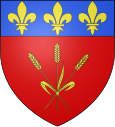Crépy (Aisne)
| Crepy | ||
|---|---|---|

|
|
|
| region | Hauts-de-France | |
| Department | Aisne | |
| Arrondissement | Laon | |
| Canton | Laon-1 | |
| Community association | Pays de Laon | |
| Coordinates | 49 ° 36 ' N , 3 ° 31' E | |
| height | 63-183 m | |
| surface | 27.7 km 2 | |
| Residents | 1,837 (January 1, 2017) | |
| Population density | 66 inhabitants / km 2 | |
| Post Code | 02870 | |
| INSEE code | 02238 | |
Crépy (formerly Crépy-en-Laonnois ) is a French municipality with 1837 inhabitants (at January 1, 2017) in the Aisne department in the region of Hauts-de-France ; it belongs to the arrondissement of Laon and the canton of Laon-1 .
history
In 1184, the French King Philippe Auguste issued the town a municipal charter . In the late Middle Ages and in the early modern period , Crépy was often fought over and was conquered in the course of the Hundred Years War in 1373 by the English , in 1418 by the Armagnacs and in 1420 by Jean de la Clite on the orders of the Burgundian Duke Philip the Good . During the Huguenot Wars , the place was captured by the Huguenots in 1568 and recaptured by the Catholic League players in 1590 .
In 1544 a peace treaty was signed in Crépy-en-Laonnois between the French King Francis I and the Roman-German Emperor Charles V (→ Peace of Crépy ).
Population development
| year | 1962 | 1968 | 1975 | 1982 | 1990 | 1999 | 2009 | 2016 |
| Residents | 1567 | 1534 | 1441 | 1543 | 1574 | 1710 | 1872 | 1869 |
Attractions
- Notre-Dame church ( Monument historique 1921), signatory place of the Peace of Crépy in 1544
- Saint-Pierre church (from 12th century, Monument historique 1921)
- Bois de l'Épine, location of the Paris gun cannon during World War I.
Personalities
- Émile Dewoitine (1892–1979), industrialist, born in Crépy
- Henri Milloux (1898–1980), mathematician, 1959 member of the Académie des sciences
